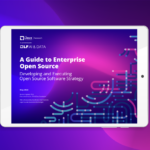A Guide to Enterprise Open Source: Why Your Organization Needs It Now

There are some universal truths about open source software (OSS). It has revolutionized our world and become the foundation of our digital society, the backbone of our digital economy, and the basis of our digital existence. Every household and enterprise brand name in technology is built upon it, whether that name is Alexa or Android, Azure, or AWS.
Open source software has played a significant part in everything from the internet and mobile apps we use every day to operating systems and programming languages used to construct the future. Even the systems we traditionally think of as being closed, such as Microsoft Windows and Apple’s Mac and iPhone, are developed using open source software.
Just as a powerful current drives the arteries of a river, open source software is the force that propels our digital economy and allows for scientific and technological advancements that benefit our lives.
But only a few decades ago, few people had even heard of open source software, and it was limited to a small group of enthusiastic devotees. Yet the concept of free and open source software (FOSS) has been around a long time, going back to the early days of the user communities for IBM mainframes and academic institutions. FOSS is software that anyone can use, study, modify, and distribute without restriction. The term “open source” was coined to describe this type of software, and the concept was formalized with the launch of the Open Source Initiative (OSI) in 1998.
Organizations involved in building products or services involving software, regardless of their specific industry or sector, are likely to adopt OSS and contribute to open source projects deemed critical to their products and services. Organizations are creating open source program offices (OSPOs) to manage their open source activities, from adopting OSS and compliance with applicable licenses to participating in open standards and foundations.
Many new industries and thousands of businesses have joined the open source revolution. Those organizations that chose a deliberate OSS strategy, incorporating best practices, methods, and engineering processes, emerged as leaders in their industries or verticals for open source initiatives.
And yet, many organizations have not embraced open source at all. Some see it as a risky undertaking, lacking a strategy to move forward, needing pathways to see the value proposition of free and open source software, and requiring migration from a risk point of view to a value point of view. In addition to challenges with open source consumption, many organizations prohibit their employees from open source contributions either on their behalf or personally in the employee’s spare time.
To help guide organizations through their own open source journeys, Ibrahim Haddad, Ph.D., Executive Director of LF AI & Data, has written a report that offers a practical and systematic approach to establishing an OSS strategy, which includes developing an implementation plan and accelerating an organization’s open source efforts.
The past two decades have been critical for open source software in enterprise engagement and adoption. The challenge for organizations is their transition from ad hoc and incidental adoption to open source value delivered back to the business using a strategic and planned methodology. This report delivers on the promise of helping enterprises establish an open source strategy, develop and execute an implementation plan, and accelerate their open source efforts to support their business goals.
Ibrahim Haddad, Ph.D.
This research is a collection of learnings and best practices that Dr. Haddad has developed, collaborating with the LF AI & Data community members who have pursued their own open source journeys for years.
Effective organizations have guided their open source usage through strategy, honed over time with communities such as LF AI & Data and the TODO Group to guide their ongoing use of OSS and their engagement with the open source ecosystem.
This report helps to address the fears of transitioning to open source and explore the many opportunities it offers by covering the following topics:
The business case for open source softwareHow to develop an open source strategyCreating an open source program officeImplementing an open source strategyMeasuring success with open sourceBest practices for organizational involvement in open source projects
The post A Guide to Enterprise Open Source: Why Your Organization Needs It Now appeared first on Linux Foundation.
The post A Guide to Enterprise Open Source: Why Your Organization Needs It Now appeared first on Linux.com.
Source: Linux.com
